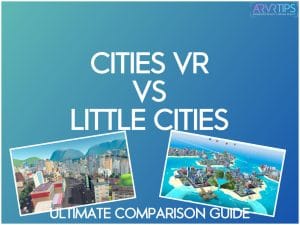Little Cities and Cities VR launched within a few months from each other, adding two quality VR city simulation games to the Meta Quest store. In this review, I go over Cities VR vs Little Cities in full detail, showing you which game is better in a number of different ways, including:
- Price
- Graphics
- Gameplay
- User Interface
- Replay-ability
- Building
- Economy Features
and more! If you have been on the fence about which VR city builder game to buy, this guide has all of your answers.
Looking for another VR simulation game to try? Deisim is an awesome world building simulator!
What is Cities: VR?

Cities VR is a city simulator game with more challenging and in-depth options for everything like roads, buildings, budgeting, and economy. The game attempts to translate the expansiveness and complexity of its parent game: Cities: Skylines.
Cities VR lets you build and manage your ideal city. You can construct buildings, bridges, handle economics, and provide emergency services. You will enjoy playing Cities VR if you believe you can create a brand new lifelike city of your own.
Overall, I found Cities VR to be a more complex city simulator game, but a lot more rewarding and immersive.
How to Buy Cities VR
What is Little Cities?

Little Cities is a new concept entirely, built from the scratch for virtual reality and published by nDreams. If you don’t want to worry about raising taxes or adjusting the budget for medical services, Little Cities is for you. The game presents as a casual simulator experience for Quest.
Little Cities is more focused on the laid-back city builder simulator: constructing roads, buildings, placing zones, seeing taxes filling up your pockets, and seeing your town grow. While no past experience is required, if you have experienceplaying city simulator games, you will quickly become familiar with the environment.
Overall, I found Little Cities to be a less immersive game, but better suited for a VR headset.
How to Buy Little Cities
Next, I will go into each VR city sim game in more detail!
Cities VR vs Little Cities: Detailed Comparison
Despite being in the same genre, Cities VR vs Little Cities are nothing alike! It’s important to understand each game so that you know which one is better for you.
Development
Cities VR immediately grabbed my attention because it is the virtual reality version of the popular Cities: Skylines game. I’ve spend hundreds of hours playing Skylines and enjoy it for its depth. It’s not easy and automatic to keep your citizens happy in the game and you have to apply real city management techniques in order to grow.
Fast Travel Games handled the development of Cities VR and were responsible for taking Cities: Skylines assets and mechanics and porting them over to virtual reality for the Meta Quest. Fast Travel is also responsible for the VR games Wrath: The Oblivion, The Curious Tale of the Stolen Pets, Apex Construct, and a few other VR games.
On the other hand, Little Cities was developed from the ground up in virtual reality and the Meta Quest. nDreams is the developer of Little Cities and they’ve created a few other VR games too – Shooty Fruity, Phantom: Covert Ops, and Ghostbusters VR.
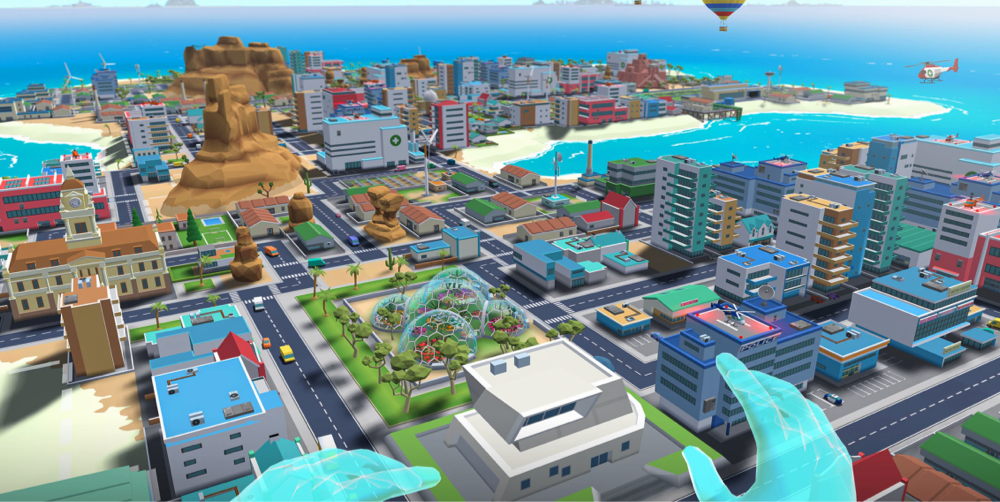
Overall, both development approaches can work good if executed properly.
Winner: Draw
Price
Cities VR currently retails for $29.99 on the Quest VR store. Little Cities is available for $19.99. Price can be a big determining factor on which game you buy, especially if you have a lean budget.
VR games are not known for going on sale too close to their release date. And neither game was included in the 2022 Quest summer sale. So, you can expect to pay the prices above for quite a while.
Winner: Little Cities
Graphics
Cities VR is a city simulator game filled with more building types, city types, and management goals. Being ported from Cities: Skylines, it is clear that Fast Travel Games had a lot of graphics assets and animations to incorporate in the game. This makes the graphics in Cities VR a bit more chaotic. I found that you are likely to run into more glitches due to the level of combinations available with roads, buildings, and terrains.
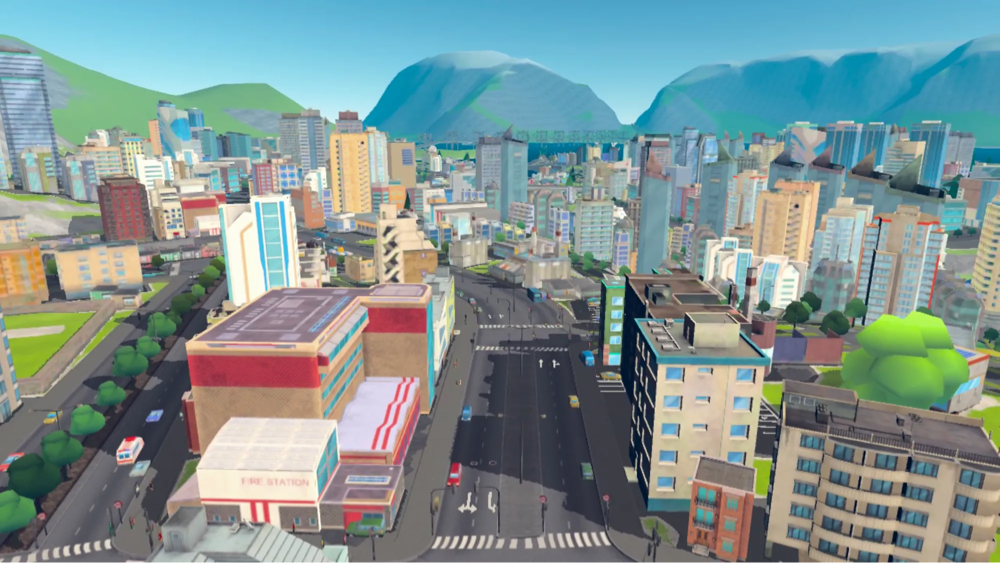
On the other hand, Little Cities is a bit more cartoon-like and more polished. Graphics are kept a little less realistic so that you can grow your city without seeing drops in frame rate on your Quest 2. Since nDreams created the game for virtual reality and started from zero, I found a lot less glitches and hiccups during gameplay.
Winner: Cities VR for graphics depth and Little Cities and graphics polish
User Interface
Cities VR uses a more traditional palace system where you power your controller and use the end lock stick to select an option from a radius of options. There are lots of options, so you will be moving front and back to the palace a lot.
Being familiar with Cities: Skylines, I found the menu system to be familiar enough to pick it up and understand it right away. However, new users will take a little bit of time getting used to all of the options and analytics buried in the menus.
On the other hand, Little Cities uses a bubble system of user interface to operate. The system lets you open each menu by popping an icon that represents that menu. The bubble system opens a cloud of little bubbles and you can pop those bubbles to select them.
The interface in Little Cities is more interactive and plays well in virtual reality. The icons are simple to understand and your options are more refined.
Overall, Cities VR has a lot more options than Little Cities. Its palace system is a lot quicker to navigate through, but you are prone to making mistakes. Little Cities has a cool VR mechanic and you have to be more deliberate about what option are your select. Between Cities VR vs Little Cities, I liked the more complex menu once I became more familiar with it.
Winner: Cities VR
Cities VR vs Little Cities Gameplay
The smaller details are nice, but how well do these two games play? And do they do virtual reality gameplay justice?
Locations
There are 9 different locations where you can build a brand new city in Cities VR. The locations vary from lakes, islands, rivers, mountains, and a combination of these. You can build in the 9 locations simultaneously as you deem necessary and play each level as you wish.
Cities VR is a true city simulator that allows you to use your imagination and build the city you want. There are not the same level of scenarios and challenges found in the original Cities: Skylines game, but I hope that they will come over to VR soon.
This narrative is a bit more different in Little Cities. Little Cities has 6 different island types that you can select. The islands in Little Cities are a collection of islands, where you can leverage to build bridges and tunnels for your cities. As you finish building a city on an island, you will have the leverage to unlock a new island to build another city.
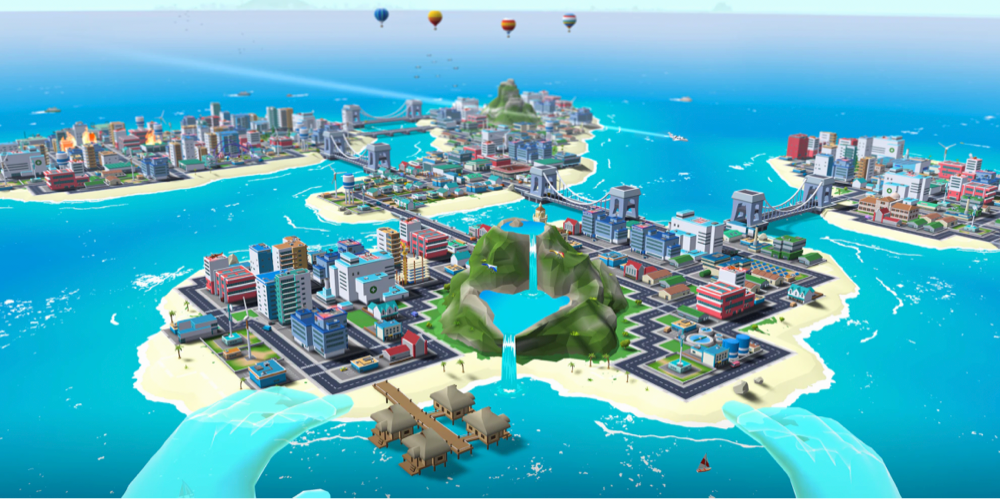
Little Cities is a city simulator, but with a little bit more of a focused path to play through.
Winner: It depends. Both are kind of weak and have room for improvement.
Roads
In Cities VR, there are around 30 roads altogether, in addition to intersections and roundabouts. The customization option is top-notch; you can build bridges and design your layout whichever way you want. As your city expands, you can upgrade roads, roundabouts, and more.
I found this kind of variation key. As you progress in a simulation game, you want to be able to upgrade and redo parts of your city to match your current situation. You want to have the ability to replace simple roads built earlier with massive freeways and updated infrastructure. If you are looking to do that kind of stuff, Cities VR has you covered.
Conversely, Little Cities has only one type of road that you can build. You can choose to lay out a road however way you want, but you’re only limited to one type of road. Customization options are also limited when building bridges and other infrastructure.
In Little Cities, your city populates around you no matter what and upgrade options are more limited. It caters to a more casual player who wants to use virtual reality hand mechanics in a simulator game, without all of the fuss and customization.
Winner: Cities VR
Building
In Cities VR, you can unlock new buildings as your population grows, but the buildings are generic across all locations. For instance, you can unlock a train station or raceway in any of the 9 locations and the look and feel is the exact same.
The unlocking of new buildings in Cities VR is one of the best components of this city building game. You get to adjust your city design to the level and popularity you are currently at.

In Little Cities as your population increases, you will be able to unlock general and specific buildings depending on the nature of the location you are building on. For instance, in a volcanic islands location, you can unlock a spa or a power plant to help the people living there.
This type of customized scenery in Little Cities is really awesome. It doesn’t effect the gameplay a whole lot, but this gives you some fresh scenery to look at while you play.
Winner: It depends. For quantity of buildings, go for Cities VR. For looks and theming, Little Cities is better.
Economy
Little Cities comes with a pretty simple economic model. In the game, you start the game with a certain amount of cash to build commercial, residential, and industrial zones. You can unlock cash bonuses in specific locations and levels to help you pay for upgrades and provide utilities in the city.
There aren’t a whole lot of ways to lose money in Little Cities. If you follow your objectives and listed to your people, you will always grow cash reserves and be able to expand.
On the other hand, Cities VR comes with a more in-depth economy. You start the game with more limited cash to provide services to your people. There are taxes, zoning areas, loans, and city budgets to manage.

Overall, the Cities VR economy is more complicated than Little Cities. You can actually fail levels in Cities VR and have to start all over again. That didn’t happen to me at all in Little Cities. This also keeps Cities VR more fresh and causes you to think about your actions and approach more.
Winner: Cities VR
People
People react a little bit differently in these two games.
In Cities VR, scaling up your towns is very important. You don’t want to build out roads, public transport, and amenities too quickly or else your expenses will grow faster than your revenue. You get to control each aspect of city planning as you build your cities up.
Keeping people happy is a more delicate balance in Cities VR. Actions tend to make some people happy and others upset. You have a bigger balancing act to perform as you grow.
In Little Cities, you have to build each island into a bustling area before you can move on and expand. You have to keep your people happy by offering them resources and programs that they’ll enjoy. You need to build water towers, cell towers, wind farms and other resources as you grow that connect your city together.
I found that the happiness of your people is most affected by what you give them and not how good – or bad – you design the city.
In Little Cities, your services are key to success. In Cities VR, proper city design is the key.
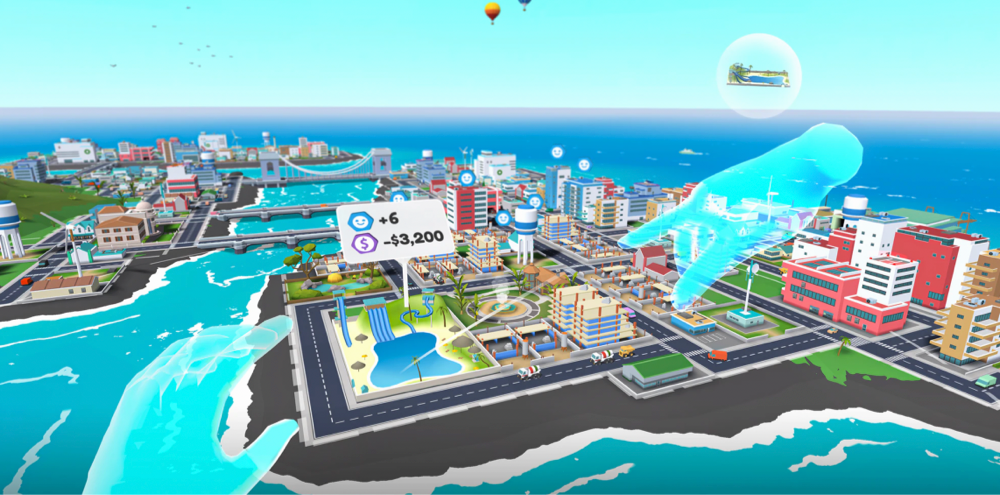
Winner: Cities VR if you have the time to dedicate to it.
Other Misc Similarities and Differences in Cities VR vs Little Cities
Natural Disasters
Natural disasters occur in both games to spice things up. In Cities VR, there are volcanic eruptions and sand stones. In Little Cities, there are things like waste management, transit roads, and some landscaping problems to overcome.
Playtime
It will take you around 5 hours of gameplay to build one city in Cities VR to the maximum population. In Little Cities, if you put in 5 hours of gameplay, you will build around 5 to 6 cities to the highest population.
Zoning
Cities VR has different zones, including industrial, low-density residential, low-density commercial, high-density commercial, and residential, and office zoning. On the other hand, Little Cities has commercial, industrial, and residential zoning.
Video Review
Want to see both apps in action? Check out the comparison review video below!
Conclusion
There is a clear theme here for those who are still on the fence. If you care about:
- Lots of customization
- Realistic city building
- Lots of trial and error
- More possibilities to succeed or fail
Then go buy Cities VR today. It does a respectable job porting Cities: Skylines to virtual reality and is a very strong city builder game.
On the other hand, if you care about:
- Better virtual reality controls
- Easier menu design
- High quality atmosphere
- Less price to pay
- A clearer end goal
Then Little Cities is for you. It was build from the ground up for virtual reality and is a less stressful experience.
Overall, VR gamers with a Meta Quest are lucky. Before 2022, there were zero VR games in the city building genre and now there are at least two quality options.
If this Cities VR vs Little Cities review caused you to buy either of these games and give them a try, comment down below and let us know which one you preferred.

